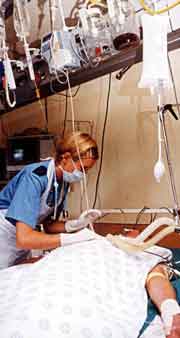

A No-show and a Mismatch.
abbreviations.
a, arterial; A, alveolar; B, barometric (i.e. of the atmosphere); C02, carbon dioxide; F, fraction; I, inhaled; mmHg or torr, pressure in millimetres of mercury (torricelli); 02, oxygen; P, partial pressure of a gas; S, saturation (%). Formulae assume partial pressures of gases in mmHg. For kPa multiply by 0.133.
A fifty-four year old man fails to turn up for his bowls game and does not
answer the telephone. Friends from the club enter his flat through the back
door and find him lying on the kitchen floor, unresponsive and breathing
stertorously. The ambulance crew find that his right limbs are floppy and
his Sa02 is 75%. He does not rouse during transport. On examination in
hospital he remains comatose, his right chest is dull to percussion and his
blood white cell count is markedly raised.
His neurological diagnosis
is a cerebrovascular accident (CVA); he has suffered a 'stroke'.
* What respiratory
system problem might be present?
* Is he significantly hypoxemic?
An arterial blood gas (ABG) sample is taken from the radial artery at the wrist. His PCO2 is 65 mmHg. He has marked hypercapnia.
* Is high-dose oxygen dangerous as he might be
insensitive to CO2 and dependent on hypoxemia to drive ventilation?
He remains severely hypoxic and hypercapnic even on high-dose inhaled oxygen.
* What measure could be used to reverse his hypoxia and hypercapnia?
He is thought to be at risk of death from respiratory failure. He is intubated
with an endotracheal tube and mechanically ventilated with 70% oxygen in
the intensive care department. He is nursed lying on his right side and
on his left side alternately with turns at two hourly intervals.
* Why?
His ABG values are noted to vary with his position. The following values are representative:
Right side up: pH 7.43, PaCO2 32 mmHg, PaO2 123 mmHg
Left side up: pH 7.45, PaCO2 30 mmHg, PaO2 76 mmHg
The function of the lungs as a whole-at least the oxygen transport function-can be summarised in a single number; the difference in partial pressure of oxygen between the alveolar gas ('A') and the arterial blood ('a'). This is known as the "alveolar-arterial gradient for oxygen" (say "Aa gradient" or "Aa difference"). Appendix I gives a derivation of this value, and in Appendix II a clinical shortcut for obtaining this is shown.
* What is the A-a difference for a healthy subject breathing room air (21% oxygen) with a PaCO2 of 40 mmHg and a PaO2 of 97 mmHg? Calculate this using either the long form (appendix I) or the shortcut (appendix II). If time, obtain both answers and consider whether the shortcut is valid.
For the two positions in which the patient is nursed, the A-a diffence is calculated as follows.
(760-47) * 0.7 - (32/0.8) + 2 - 123 = 338.1 mmHg
Left side up: FI02 0.7, PaCO2 30 mmHg, PaO2 76 mmHg:
(760-47) * 0.7 - (30/0.8) + 2 - 76 = 387.6 mmHg
* How does the Aa difference in this patient compare with the value expected at his age?
| Appendix I. The Alveolar-arterial Gradient for Oxygen. The alveolar-arterial gradient for oxygen (in spoken form, the "Aa gradient" or "Aa difference") allows the function of the lungs in transferring oxygen from air to blood to be expressed in a single figure (expressed as mmHg, i.e. as a pressure difference). The first step in calculating this (the alveolar gas equation) takes into account the reduction in PO2 in the lungs (compared with the oxygen in the inhaled gas) caused by the presence of carbon dioxide in the lungs. The Alveolar Gas Equation.
PA02 = PI02 -PaCO2/R + f
R is the 'respiratory exchange ratio', indicating the ratio of carbon dioxide produced to oxygen consumed and arising from the action of cellular respiration, and is somewhat variable with diet. Assume R = 0.8. PI02, the partial pressure of inhaled oxygen, is obtained from the pressure of atmospheric gas, the water vapour pressure, and the oxygen fraction of the inspired gas, by the following formula
PI02 = (PB - PH20) X FI02
PH20, the water vapour pressure, is the "humidity" of the gas. This depends on the water saturation and the temperature. At normal body temperature the inhaled gas is fully saturated with water in the upper airways and PH20 is 47 mmHg. FI02 is the fraction of oxygen in the inspired gas mixture. Room air is 21/100 or 0.21; gas administered by mask or by machine may exceed this. The Alveolar-arterial Gradient (Aa gradient) for oxygen. P(A-a)O2 = PA02 - PaO2 where: PAO2 is obtained from the alveolar gas equation and PaO2 from arterial blood gas results. |
| Appendix II. A Shortcut for the A-a Difference. In clinical practice shortened forms of equations are often sufficient for everyday tasks. Here is an abbreviated version of the alveolar gas equation used at the Middlemore Hospital Emergency Department (source, Wayne Hazell. Emergency medicine at your fingertips. Roche Auckland 1998; p. 30): PAO2 = [710 X FI02] - [PaCO2 X 1.25]
Alveolar-arterial oxygen gradient P(A-a)O2 = PAO2 - PaO2 |